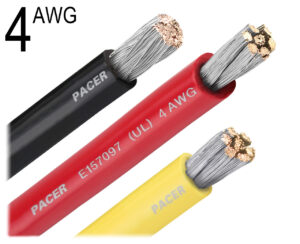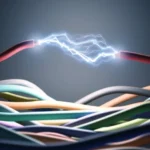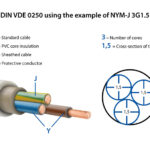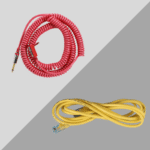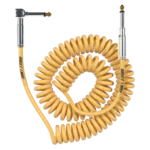When it comes to battery cables, selecting the right wire gauge is crucial for ensuring optimal performance, safety, and longevity of your electrical systems. Whether you're working on automotive applications, marine setups, solar installations, or industrial equipment, understanding battery cable specifications can make all the difference between a reliable system and potential hazards.
Understanding Wire Gauge for Battery Cables
Battery cables typically use the American Wire Gauge (AWG) system, where counterintuitively, lower numbers indicate thicker wires. For battery applications, common gauges include:
- 00 AWG (2/0): Heavy-duty applications requiring maximum current flow
- 0 AWG (1/0): High-performance automotive and marine applications
- 2 AWG: Standard for many automotive and medium-duty applications
- 4 AWG: Smaller vehicles and lower amperage applications
- 6 AWG: Light-duty applications with minimal current requirements
Factors Affecting Battery Cable Gauge Selection
Several key factors determine which gauge is appropriate for your specific battery application:
1. Current Requirements
The amount of electrical current (measured in amperes) flowing through your system is perhaps the most critical factor in selecting battery cable gauge. Higher currents require thicker cables to prevent overheating and voltage drop.
Quick Reference Guide for Maximum Current Capacity:
- 6 AWG: Up to 55 amps
- 4 AWG: Up to 70 amps
- 2 AWG: Up to 95 amps
- 1/0 AWG: Up to 125 amps
- 2/0 AWG: Up to 170 amps
- 4/0 AWG: Up to 230 amps
2. Cable Length
Longer cable runs experience greater resistance, resulting in voltage drop. For every additional foot of cable length, you may need to increase the gauge (decrease the AWG number) to maintain proper voltage at the destination.
Rule of thumb: For every 10 feet of additional cable length beyond your baseline calculation, consider going up one gauge size.
3. Application Type
Different applications have different requirements:
- Automotive Starting Cables: Most passenger vehicles use 4-2 AWG for starter cables, while larger trucks and high-performance vehicles may require 1/0 or 2/0 AWG.
- Marine Applications: Due to the corrosive environment and higher vibration, marine applications typically require heavier gauge cables (2 AWG to 4/0 AWG) with specialized insulation.
- Solar Energy Systems: Deep cycle battery connections in solar setups commonly use 2 AWG to 2/0 AWG depending on the system's size and amperage.
- Industrial Equipment: Forklifts, backup power systems, and industrial machinery often require heavy-duty 2/0 to 4/0 AWG cables.
Battery Cable Construction
Quality battery cables consist of several components:
Conductor Material
While most battery cables use copper as the primary conductor due to its excellent conductivity, you'll find two main types:
- Pure Copper: Offers the best conductivity but at a higher price point
- Copper-Clad Aluminum (CCA): More affordable but with slightly less conductivity
Insulation Types
The insulation material determines the cable's durability, temperature resistance, and application suitability:
- PVC (Polyvinyl Chloride): Common, economical, and suitable for most general applications
- EPDM (Ethylene Propylene Diene Monomer): Superior heat resistance and flexibility
- Cross-Linked Polyethylene (XLPE): Excellent for high-temperature environments
- TPE (Thermoplastic Elastomer): Combines the properties of rubber and plastic for increased durability
Special Considerations for Different Applications
Automotive Systems
For standard passenger vehicles, 4 AWG is typically sufficient for battery cables. However, vehicles with high-output alternators, powerful stereo systems, or multiple batteries may require 2 AWG or even 1/0 AWG cables.
The starter motor draws the highest current in a vehicle's electrical system, often requiring 2 AWG to 1/0 AWG cables depending on the engine size and starter requirements.
Inverter Systems
When connecting batteries to power inverters:
- For inverters up to 1000W: 4 AWG minimum
- For inverters 1000W-2000W: 2 AWG recommended
- For inverters 2000W-3000W: 1/0 AWG recommended
- For inverters above 3000W: 2/0 AWG or larger
Marine Applications
Marine environments demand special attention due to moisture, salt, and vibration:
- Small boats (under 25 feet) typically use 4-2 AWG
- Mid-size vessels use 2 AWG to 1/0 AWG
- Larger boats may require 2/0 AWG or thicker
- Always use marine-grade tinned copper for corrosion resistance
Temperature Considerations
Battery cables often operate in challenging temperature environments. The cable's ampacity (current-carrying capacity) decreases as temperature increases. For every 10°C above the standard 30°C operating temperature, you should derate your cables by approximately 10-15%.
Installation Best Practices
- Keep cables as short as possible to minimize resistance and voltage drop
- Use high-quality terminals that match your cable gauge
- Properly crimp or solder connections rather than just clamping
- Protect cables from abrasion using grommets when passing through metal surfaces
- Install appropriate fuses within 18 inches of the battery for safety
- Secure cables to prevent movement and vibration damage
Troubleshooting Common Issues
Voltage Drop
Excessive voltage drop (typically more than 0.5V under load) indicates undersized battery cables. This can cause poor starting performance, dimming lights, and other electrical issues.
Overheating
Cables that become noticeably warm during operation are likely undersized for the current they're carrying. This can lead to insulation failure and potentially dangerous situations.
Conclusion
Selecting the proper gauge wire for battery cables is essential for system performance and safety. By considering factors such as current requirements, cable length, application type, and environmental conditions, you can ensure your battery cables provide reliable service while minimizing voltage drop and heat generation.
Remember that investing in high-quality, properly sized battery cables pays dividends in system efficiency, reliability, and safety. For critical applications, consulting with a qualified electrical engineer or following manufacturer specifications is always recommended.
For more information on our complete range of battery cables and other wire and cable products, please explore our product catalog or contact our technical support team for personalized assistance with your specific application.

